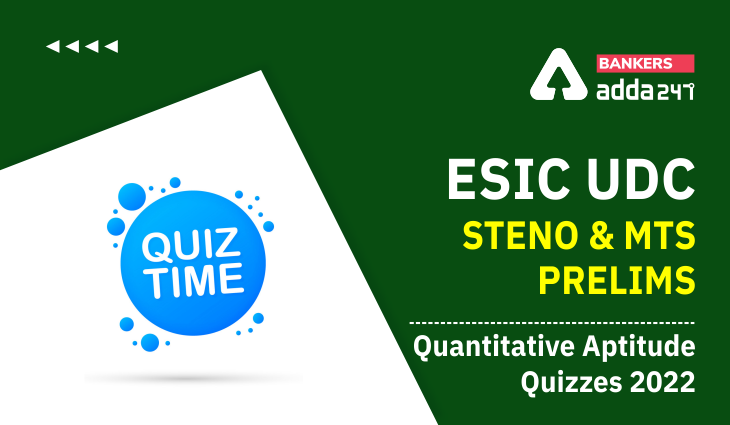Directions (1-10): Each question below contains two quantities, Quantity I and Quantity II. Find both, if needed, to know the relationship among them. Mark your answer accordingly.
Q1. Quantity I: Find the length of train running at 54 kmph which cross the platform of length 90 meters in 18 seconds. (in meters)
Quantity II: 185 meters
(a)Quantity I>Quantity II
(b)Quantity I<Quantity II
(c)Quantity I≥Quantity II
(d)Quantity I≤Quantity II
(e)Quantity I=Quantity II or no relation can’t be established.
Q2. Quantity I: Rs. 460
Quantity II: A retailer sold an item to customer at Rs. 2360 which was marked up by 20% above cost price while the difference between marked price and cost price is Rs. 400. Find the profit or loss? (in Rs.)
(a)Quantity I>Quantity II
(b)Quantity I<Quantity II
(c)Quantity I≥Quantity II
(d)Quantity I≤Quantity II
(e)Quantity I=Quantity II or no relation can’t be established.
Q3. Quantity I: The probability of getting a sum, which is a prime number, if two dices are thrown simultaneously.
Quantity II: 5/12
(a)Quantity I>Quantity II
(b)Quantity I<Quantity II
(c)Quantity I≥Quantity II
(d)Quantity I≤Quantity II
(e)Quantity I=Quantity II or no relation can’t be established.
Q4. Quantity I: 42 km
Quantity II: A boat covers a distance of 80 km in 5 hours in still water, If the upstream speed is 12 kmph. Find the distance travelled by same boat in 2 hours downstream. (in km)
(a)Quantity I>Quantity II
(b)Quantity I<Quantity II
(c)Quantity I≥Quantity II
(d)Quantity I≤Quantity II
(e)Quantity I=Quantity II or no relation can’t be established.
Q5. Quantity I: Find the present age of A if 8 years from now ratio of ages of A to B will be 6:7. Meanwhile their respective ratio of present ages is 2:3. (in years)
Quantity II: 8 years.
(a)Quantity I>Quantity II
(b)Quantity I<Quantity II
(c)Quantity I≥Quantity II
(d)Quantity I≤Quantity II
(e)Quantity I=Quantity II or no relation can’t be established.
Q6. Quantity I: Rs. 2500
Quantity II Find the sum if the compound interest for 2 years at the rate of 20% per annum is Rs.1100. (in Rs.)
(a)Quantity I>Quantity II
(b)Quantity I<Quantity II
(c)Quantity I≥Quantity II
(d)Quantity I≤Quantity II
(e)Quantity I=Quantity II or no relation can’t be established.
Q7.Quantity I: 102
Quantity II: Find the value of ‘n’, if a man covers a total distance of ‘n’ km in 12 hours, out of which first half was covered at 6 kmph and second half at 12 kmph.
(a)Quantity I>Quantity II
(b)Quantity I<Quantity II
(c)Quantity I≥Quantity II
(d)Quantity I≤Quantity II
(e)Quantity I=Quantity II or no relation can’t be established.
Q8.Quantity I: y;y² -3y – 40 = 0
Quantity II: x;x² + 16x + 55 = 0
(a)Quantity I>Quantity II
(b)Quantity I<Quantity II
(c)Quantity I≥Quantity II
(d)Quantity I≤Quantity II
(e)Quantity I=Quantity II or no relation can’t be established.
Q9.Quantity I: x;2x² – 9x + 9 = 0
Quantity II: y;y² – 13y + 30 = 0
(a)Quantity I>Quantity II
(b)Quantity I<Quantity II
(c)Quantity I≥Quantity II
(d)Quantity I≤Quantity II
(e)Quantity I=Quantity II or no relation can’t be established.
Q10.Quantity I: x;x² + 5 x – 6 = 0
Quantity II: y;y² – 5 y + 6 = 0
(a)Quantity I>Quantity II
(b)Quantity I<Quantity II
(c)Quantity I≥Quantity II
(d)Quantity I≤Quantity II
(e)Quantity I=Quantity II or no relation can’t be established.
Directions (11-15): Each question below is followed by two statements, statement I and statement II. Read the statements and mark your answer accordingly.
Q11.Find the time taken by boat to cover 120 km in still water? (in hours)
Statement I: A boat covers 60 km in upstream and downstream in 13 hours.
Statement II: A boat covers 120 km upstream in 20 hours while same boat covers 180 km downstream in 9 hours.
(a) Only statement I alone is sufficient to answer the question.
(b)Only statement II alone is sufficient to answer the question.
(c)Either of the statement I or statement II is sufficient to answer the question.
(d)Both the statement I and statement II are sufficient to answer the question.
(e)Neither statement I nor statement II is sufficient to answer the question.
Q12. Find the length of train A? (in meters)
Statement I: The speed of train A and train B is 72 kmph and 108 kmph respectively, whereas the respective ratio of their lengths is in the ratio of 3:2.
Statement II: Train B crosses train A, which is running in opposite direction in 9 seconds.
(a) Only statement I alone is sufficient to answer the question.
(b)Only statement II alone is sufficient to answer the question.
(c)Either of the statement I or statement II is sufficient to answer the question.
(d)Both the statement I and statement II are sufficient to answer the question.
(e)Neither statement I nor statement II is sufficient to answer the question.
Q13. Find the profit or loss percent acquired by the shopkeeper when he sold an article by offered some discount?
Statement I: A shopkeeper sold an article at Rs. 4800 which was marked up by 25%.
Statement II: Two successive discount of 10% and x% were given on the article.
(a) Only statement I alone is sufficient to answer the question.
(b)Only statement II alone is sufficient to answer the question.
(c)Either of the statement I or statement II is sufficient to answer the question.
(d)Both the statement I and statement II are sufficient to answer the question.
(e)Neither statement I nor statement II is sufficient to answer the question.
Q14. Find the number of days taken by A and B to complete the work together?
Statement I: Efficiency of A is thrice of B while number of days taken by A is 8 less than the number of days taken by B.
Statement II: The number of days taken by A, B & C to complete a work is 6 days while A do same work in 24 days.
(a) Only statement I alone is sufficient to answer the question.
(b)Only statement II alone is sufficient to answer the question.
(c)Either of the statement I or statement II is sufficient to answer the question.
(d)Both the statement I and statement II are sufficient to answer the question.
(e)Neither statement I nor statement II is sufficient to answer the question.
Q15. Find the total number of red balls in the bag?
Statement I: The probability of drawing one green ball from a bag containing 4 green balls, 3 blue and x red balls is 1/10.
Statement II: The probability of drawing one red ball from a bag containing 3 green ball and remaining red and blue balls is 3/8.
(a) Only statement I alone is sufficient to answer the question.
(b)Only statement II alone is sufficient to answer the question.
(c)Either of the statement I or statement II is sufficient to answer the question.
(d)Both the statement I and statement II are sufficient to answer the question.
(e)Neither statement I nor statement II is sufficient to answer the question.
Solutions






 GA Capsule for SBI Clerk Mains 2025, Dow...
GA Capsule for SBI Clerk Mains 2025, Dow...
 The Hindu Review October 2022: Download ...
The Hindu Review October 2022: Download ...
 How to Start Preparing for IBPS PO from ...
How to Start Preparing for IBPS PO from ...





